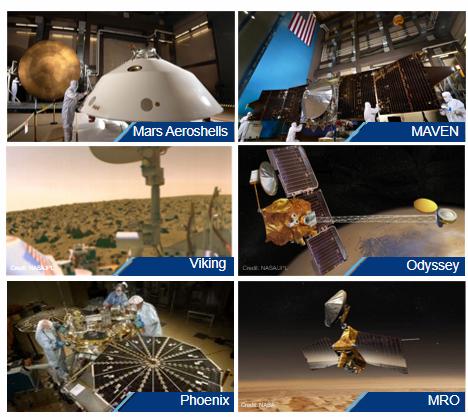For over five decades, Lockheed Martin has been a cornerstone of NASA’s most ambitious planetary science missions, from the Viking landers that first touched Mars’ surface to the cutting-edge OSIRIS-REx spacecraft that retrieved asteroid samples. Today, the company is tackling one of humanity’s most complex robotic endeavors: Mars Sample Return (MSR), a mission that could redefine our understanding of the Red Planet and its potential to harbor life.
Lisa May, Lockheed Martin’s Senior Manager for Deep Space Exploration Strategy, whose team embodies the “Lockheed Martians” moniker earned through decades of Mars mission expertise, stands at the forefront of this effort. At the 40th Space Symposium, she provided the latest updates on MSR and Lockheed Martin’s other deep space endeavors.
A Legacy Forged on Mars… and Beyond
Lockheed Martin boasts an unparalleled deep space pedigree. The company has contributed to all 22 of NASA’s Mars missions, designing and operating iconic spacecraft like the Mars Reconnaissance Orbiter (MRO), which has circled Mars since 2006, and the Phoenix Lander, which confirmed water ice on the planet’s surface in 2008.

Their deep space scientific work extends well beyond Mars, though, and includes:
- Stardust (1999): First mission to return comet dust to Earth.
- Genesis (2001): Captured solar wind particles, revealing secrets of the Sun’s composition.
- OSIRIS-REx (2016): Retrieved samples from asteroid Bennu and safely brought them to Earth.
- Lucy (2021): Currently touring Jupiter’s Trojan asteroids to unravel solar system history.
Expanding Horizons: Operational Mastery and Sample Science
Lockheed Martin doesn’t just make space vehicles. It provides full spectrum support from its Mission Support Area near Denver, to ensure spacecraft operate reliably and adaptively across the entire solar system.
This facility is more than a nerve center; it’s a testament to operational excellence. Teams there have managed everything from the Hubble Space Telescope’s diagnostics to OSIRIS-REx’s precision asteroid sampling. They have orchestrated missions for 35+ years and know how to balance cost efficiency with technical precision. “We’ve logged over 1 million flight hours across our missions,” May noted. This deep experience in deep space enables the company to continue to support a wide variety of ventures.
The company’s expertise in planetary protection and sample handling seems equally formidable. Missions like Genesis and Stardust pioneered protocols for extraterrestrial material handling, including triple-layer encapsulation to guard against contamination, rigorous decontamination protocols and digital chain-of-custody systems to track every sample from space to Earth laboratories. “Imagine handling a 4-billion-year-old time capsule,” May remarked. “One mishap could erase secrets of Martian evolution — or worse, risk ecosystem exposure.”
Mars Sample Return (MSR): The Ultimate Cosmic Puzzle
With this expertise as a backdrop, Lockheed Martin now stands poised at what arguably represents the pinnacle of robotic space exploration: the MSR mission. NASA’s Perseverance rover has spent years collecting 30+ scientifically curated samples from the planet’s Jezero Crater, an ancient lakebed rich in clays and carbonate — materials ideal for preserving signs of microbial life.
Sample Science and Hazard Analysis
May emphasized that the science of MSR begins with the careful selection and collection of samples by Perseverance, which acts as a robotic geologist on Mars. The samples — rock, soil, and atmospheric — are chosen for their potential to reveal Mars’ geologic history and the possibility of extinct or even extant life. “Jezero Crater was selected for its tremendous variety of terrain and geologic ages,” she explained, noting that the diversity of samples could answer fundamental questions about the Red Planet’s past.
Once returned, these samples will undergo initial characterization in specialized containment facilities on Earth, where scientists will use the most advanced instruments available to detect tiny signals — biosignatures, organics, and isotopic ratios — while maintaining contamination-free protocols. The importance of this process cannot be overstated. “We’re bringing back very, very sophisticated equipment in order to detect tiny signals in a contamination-free way, so that one sample doesn’t contaminate the other and you get exquisite science,” May said.
But this scientific quest is not without risk. Mars is full of surprises, May explained, from its crypt-like surfaces that once trapped the Spirit rover, to unknown hazards that could be present in the samples themselves. “Hazard analysis is critical,” May stressed. “We have to determine if anything in the sample is so hazardous that we cannot release them to additional laboratories for further investigation.”
All of this work is not just for planetary protection — it’s also a dress rehearsal for human exploration in general. It will help future astronauts understand and mitigate Martian hazards like sharp regolith, perchlorates, and radiation.
The Mission Architecture
According to May, returning these samples to Earth requires a symphony of engineering:
- Sample Retrieval Lander (SRL): A proposed lander would deploy a fetch rover to collect Perseverance’s sample tubes.
- Mars Ascent Vehicle (MAV): A two-stage rocket, smaller than a human, must launch the samples into Mars orbit – a first for robotic missions.
- Earth Return Orbiter (ERO): Developed with the European Space Agency (ESA), this spacecraft will capture the sample container in Mars orbit and return it to Earth by the early 2030s. ESA’s role in the ERO underscores the global stakes, with samples destined for labs worldwide.

“It’s a turducken of a mission,” May quipped, in reference to the nested complexity of systems required to preserve sample integrity and ensure protection from back-contamination. Lockheed Martin’s expertise in entry, descent and landing (EDL) — honed through missions like InSight and Phoenix – is critical to safely delivering the SRL and MAV to Mars’ surface.
Lessons from the Asteroid Frontier
Lockheed Martin’s OSIRIS-REx mission to asteroid Bennu has been a proving ground for MSR’s design philosophy. The mission’s autonomous navigation, sample acquisition and contingency planning—such as backup gas burst collection methods—have inspired similar redundancies and flexibility in the MSR architecture. “Bennu taught us that space hates complacency,” May remarked. “Every system has a Plan B—and sometimes a Plan C.”
Guardians of Sample Integrity
Lockheed Martin will also directly apply its experience with sample return missions like Stardust and Genesis to MSR’s containment and planetary protection systems. These include robust entry, descent, and landing (EDL) technologies and advanced capsule sealing.
International Collaboration
The international nature of MSR is also central: ESA’s Earth Return Orbiter will feature a European-designed robotic arm to capture the sample container in Mars orbit. Sample curation will be shared among labs in the U.S., France, and Germany to ensure global scientific access and diverse analytical perspectives.
A Costly Venture…Worth It
MSR’s $7 billion price tag and technical hurdles have sparked debates about prioritization. For example, Martian dust storms, unpredictable terrain and potential biohazards demand robust containment systems.
However, Lockheed Martin argues the scientific return on investment is unmatched. May explained, “These samples could answer whether life ever existed on Mars.” Beyond this, Mars is a gateway mission and MSR is a stepping stone for human exploration. “Understanding Mars’ hazards is vital for astronaut safety,” she said.
May re-emphasized that the MSR samples are more than simply scientific treasures — they are scouts for future explorers. “These samples will tell us where to build, what to avoid and how to survive,” she said, referencing ongoing studies into regolith risks, perchlorate mitigation, and radiation shielding, all informed by data from ongoing Mars orbiters like MAVEN and Odyssey.
She continued, “Our job is to turn scientists’ ‘I wish’ into ‘We did.” For MSR, this means rigorous requirement management and resisting scope creep – lessons learned from years upon years of planetary missions. For example, to decrease expenses, Lockheed Martin has taken a “heritage-first” approach to minimize new designs and leverage proven technologies like the Genesis sample return capsule.

“We bring our knowledge and expertise from 50 years of planetary missions to bear, focusing on managing key requirements, reducing complexity by leveraging heritage, flight-proven elements and limiting new designs to only those needed to close the architecture.” This philosophy, she noted, has even allowed Lockheed Martin to occasionally return money to the government on past missions — an almost unheard-of feat in the world of deep space exploration.
The Road Ahead: Keeping Science In the Driver’s Seat
While MSR dominates headlines, Lockheed Martin’s pipeline includes several other trailblazing projects:
- Dragonfly: A nuclear-powered drone that will explore the methane lakes on Titan, Saturn’s moon, seeking prebiotic chemistry – set to launch in 2027.
- VERITAS & DAVINCI: Twin Venus missions will map the planet’s surface and analyze its toxic atmosphere.
- Lunar Infrastructure: Lockheed Martin’s lunar projects include contributions to the Artemis program and the NextSTEP-2 habitat prototype. As these will leverage MSR-derived technologies for dust protection and habitat sealing, they illustrate how lessons learned on Mars will benefit future lunar and deep space missions.
As budget discussions loom, Lockheed Martin’s message is clear: Mars Sample Return isn’t just about rocks. It’s about igniting a new era of discovery, one where Earth’s labs can scrutinize Martian history with unprecedented precision. With May’s team at the helm, the dream of touching a piece of Mars — and other places in the cosmos — inches us ever so closer to a new reality.
For more on Lockheed Martin’s deep space missions, visit their Deep Space Exploration Capabilities.
Watch Lisa May and other space experts on the Full Crew event stream from the show floor of the 40th Space Symposium 2025.

